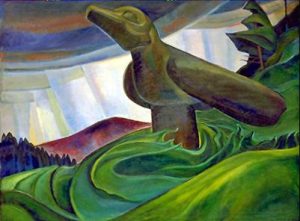Emily Carr was born in Victoria in 1871 and is widely credited as being one of the first Canadian painters to adopt a Modernist and Post-Impressionist style.
Her early works were inspired by the Indigenous people of the Pacific Northwest.
Often linked with the Group of Seven (a notable group of Canadian artists), Carr was not only an artist but a skilled writer, experts state she is arguably one of the earliest writers about life in British Columbia as her works chronicled this time.
She studied for a time in Paris, determined to increase her knowledge of evolving artistic trends.
Returning to Canada, as she matured, the focus of her painting shifted from Aboriginal inspired work to more landscape paintings (which draws comparisons with Tom Thomson), she was particularly fond of, and skilled at, painting forest scenes.
During an exhibition on West Coast aboriginal art Carr met members of the Group of Seven, at that time probably Canada’s most highly recognized modernistic painters.

The group welcomed her in to the ranks of Canada’s leading modernist painters, stating that “she is one of us”.
After this chance encounter Carr went on to create most of her recognizable works, in fact art historians claim that this was her most prolific period, as the Group of Seven influenced her direction.
Later in life, suffering from ill health after several heart attacks and a serious stroke, Carr’s work reveal her concerns about the impact of British Columbia’s growing industry on the environment and indeed Indigenous peoples, the inspiration for her early works.
Especially noticeable is her anxiety over the logging industry and its environmental impact.
Carr is considered a “Canadian Icon” and “an artist of stunning originality and strength”.
Her works for which she was best known were from her later decades.
During her varied life, she battled against all odds, as at that particular time she was living in what art historians claimed to be “an artistically unadventurous society” and calling her “a darling of the women’s movement”.
Due to her widespread recognition and influence there are several institutions named after Carr, including the Emily Carr University of Art and Design in Vancouver.
This story is brought to you by Edmonton Mudjacking. Get your concrete leveled by visiting us at www.edmontonmudjacking.com